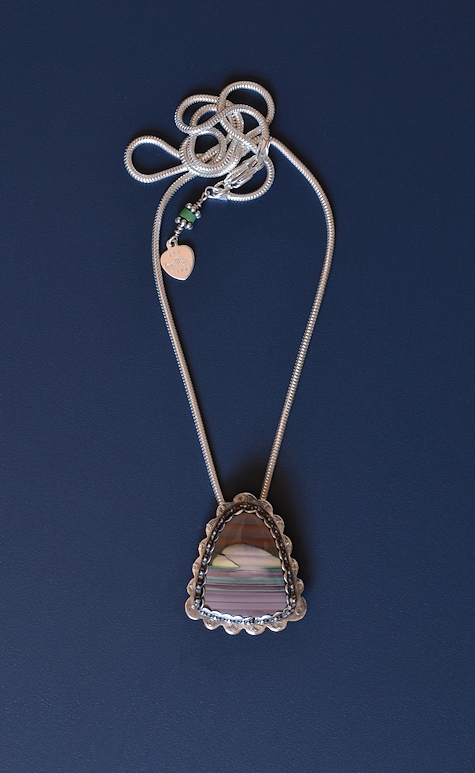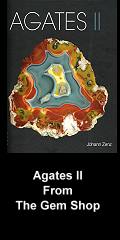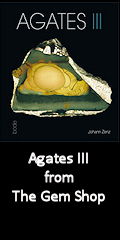Thom Lane used to cut gorgeous cabs, but now focuses on astounding agate specimens. I felt very fortunate that he brought some his old cabs to Tucson for me to choose from. I wish I could have bought them all! This little imperial jasper has a beautiful picture in unusual colors and seemed perfect for my new "line" of sweet, simple pendants.
I have complained before that Dr. Pough gives agate short shrift. In fact, "shrift" comes from the archaic verb shrive, meaning to impose a penance upon. Agates get the penance of being confined to only two paragraphs in his book, whereas poor jasper gets only four sentences! He does give it this, "jasper is often colorful..." Well, yes. Actually astonishingly so. Even our metaphysical texts don't bother with very many varieties of jasper, offering discussions of only a very few types. So our dear Johann Zenz steps up and gives jasper a comprehensive treatment in Agates II and includes a beautiful Royal Imperial jasper, and he gives Imperial jasper itself a full two pages in Agates III. Ron Gibbs gives Imperial jasper a full page tribute as well. Apparently the mauves and purples in our stone are much less common than the greens and yummy pinks you've seen in my work before. So far I haven't seen mention of the pretty turquoise color that occurs in this stone at all. So our tiny stone is quite unusual, undoubtedly older stock. It does bear a faint resemblance to one of H. Gamma's "exceptional Mexican Imperial jaspers" shown on pg. 487 of Agates III, though to my eye this one is much more beautiful. Zenz mentions that the first Imperial jasper was available on the American market in the '50s. He says it comes from north west of Guadalajara, bordering Jalisco and Zacatecas.
While Melody doesn't discuss Imperial jasper specifically, she offers a couple of pages on "jasper" in which she mentions that "...this mineral is known as the 'supreme nurturer.'" She says that it can be used to soothe the nerves and indeed you may find this piece has a calming energy. Please note that when I mention something from one of these books, it is only a teaser to encourage you to look at the extensive information they offer on the subject.
I've been puzzling over this stone because when I hold it, I know it couldn't be anything other than Imperial, yet it's hard to explain why that is. We've established that it doesn't look that much like most Imperial in color, and while it does have a couple of orbs or eggs, they are incomplete and still rising from the banded sea (orbs also occur in other jaspers, notably Morrisonite and Bruneau). So does each species really have its own particular energy which people can sense? Why not order this little pendant and determine the answer for yourself?







